2020 Virtual Health Make-A-Thon Fosters Health Innovation
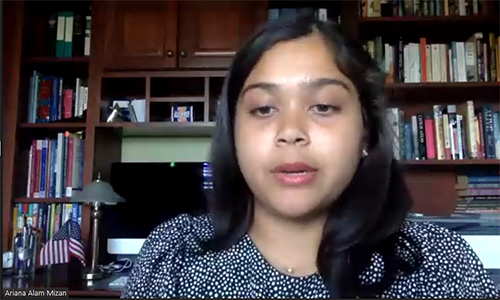
Fifteen-year-old Ariana Mizan gives her 2-minute pitch about the PillSafe Cap, one of the ten winning ideas, during the 2020 Health Make-a-Thon.
“Just the thought of maybe seeing my idea come to life and be used in the real world is surreal.” – Ariana Mizan, about her winning PillSafe Cap idea.
August 18, 2020
“Democratization of health innovation by creating a culture of innovation.” According to Irfan Ahmad, Health Maker Lab Executive Director and Carle Illinois College of Medicine (CI MED) Assistant Dean for Research, this was the goal of the 2020 Virtual Health Make-A-Thon. Held via Zoom on Saturday, August 8th, the competition narrowed the 20 finalists down to 10 winners. These would shortly receive their prize—a Maker Lab Innovation coin that would entitle the bearer to $10,000-worth of resources from the University of Illinois’s Health Maker Lab Network (HML).
Given that Make-a-Thon winners are to receive resources from the Health Maker Lab, it’s important to know exactly what the HML is. Its website describes it as this:
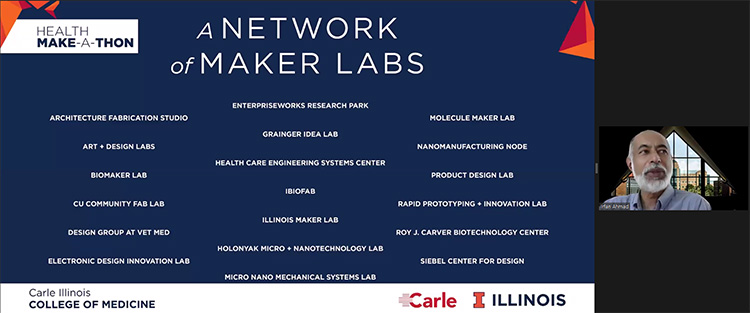
During the Make-a-Thon competition held via Zoom, Irfan Ahmad presents a slide listing 19 Health Maker Lab Nodes.
“A network of maker labs and design spaces across the University of Illinois campus that agree on one goal: to improve the world’s health.”
Currently comprised of 19 (soon to be 20) maker labs across the campus—or nodes—HML’s motto is: “If you can dream it, we will help you make it.” Several nodes, which reflect the diversity of disciplines represented in the HML, include the Architecture Fabrication Studio, the C-U Community Fab Lab, the Grainger Idea Lab, the Materials Research Lab, the Holonyak Micro and Nanotechnology Laboratory, and the Siebel Center for Design, to name a few.
Led by the HML and CI MED, the 2020 Health Make-a-Thon was also sponsored by Autodesk, Busey Bank, Carle Clinic, and the University of Illinois at Urbana-Champaign.

Nekita Thoms discusses her team's winning idea, "Projectscape" during her team's 2-minute pitch.
Key to the competition, of course, were the innovative, health-related ideas presented by the 20 finalists, who had been narrowed down from 75 original submissions from across 16 counties in Illinois. While last year’s competition had been confined to Champaign County, this year, the Make-a-Thon leadership opened it up to the entire state, partnering withthe University of Illinois College of Agricultural, Consumer, and Environmental Sciences’ Extension Office, which advertised the competition throughout Illinois, especially in rural areas and the southern part of the state.
To help winnow the 75 original competitors down to 50, a pool of 35 online judges comprised of academia, healthcare providers, investors/entrepreneurs and community members weighed in on the promising nature of the idea; thereafter, a technical review was implemented to determine its feasibility, little to no overlap with any existing ideas or products, and its promise for broad societal impact in order to come up with the final 20. Instrumental in this step were folks from the Office of Technology Management and also Grainger Engineering’s Technology Entrepreneur Center.
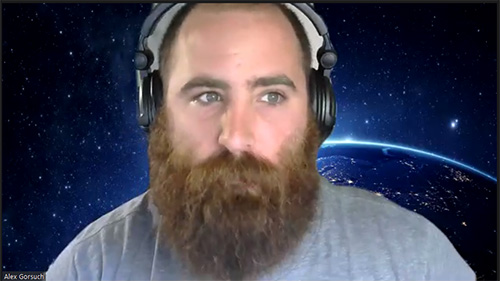
Dolphin Tank judge Alex Gorsuch listens to a finalist's response to a question he asked during a 1-minute question period.
Also crucial in the competition itself was a group of folks who comprised the Dolphin Tank, a gentler, friendlier rendition of the oft-merciless judges from the Shark Tank TV show, who treat budding entrepreneurs without compassion. “The name Dolphin Tank is intentionally selected to indicate that they are friendly judges and their role is to encourage and ask any clarification questions,” Ahmad explains. The 22 Dolphin Tank judges represented three categories: Community member/K-12 Educator/Other, Industry Representative/Entrepreneur, and Scientist/Engineer/Healthcare Provider. Several of the judges included Don Elmore, Director of the Small Business Development Center at Champaign County EDC; Alex Gorsuch, an engineering consultant and serial entrepreneur who currently serves as an Entrepreneur-in-Residence at the EnterpriseWorks; King Li, Dean of CI MED; Lynn Hassan Jones, a radiologist and community organizer; and Isaac McCoy, an educator, professional mentor, and business development executive who is currently the Dean of the School of Business at Stillman College.
Also included in this year’s Dolphin Tank were two members of last year’s cohort—winners who have been making a steady progress toward prototyping of their innovation idea(s). One was Sarah Nixon, whose project was Miniature Horse Power. The other was Yusef Shari'ati, whose project was a Mobile Phototherapy Suit. Also on the Dolphin Tank were a middle high school student, Paradise Jamal, along with other citizen scientists and community members, including some from Chicago.
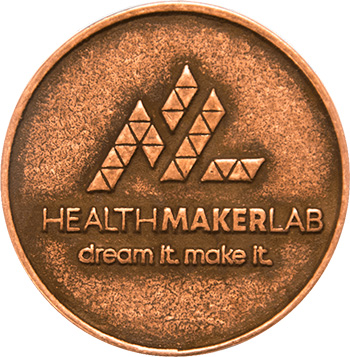
HML Innovation coin, which equals $10,000-worth of HML resources. (Image courtesy of the HML website.)
Another group of folks key to the competition process were the 34 mentors. According to Ahmad, at least two were assigned to each finalist to help them with their 2-minute pitch preparations, plus also provide “a little bit of insight on the technical idea that they have and whether it needs a little bit of tweaking, or pointing finalists to other literature resources, so they have a better contextual understanding of their idea.” Some from among the mentor pool included Joseph Irudayaraj, professor in Bioengineering; Jacob Sosnoff, a professor in the College of Applied Health Sciences; Molly Briggs, an assistant professor in Art+Design; Leana Labriola, DO, Rajul Gandhi, Pharma, and Mehmoodur Rasheed, MD, Carle Clinic; Kiel Gilleade, Applied Research Institute, and others.
Due to COVID-19, a number of changes in the entire process occurred this year compared to last. First, the competition itself was postponed from March to August. Also, some of the mentoring, which last year had taken place in person at different places around or off campus in addition to via email, and/or phone, was conducted this year via Zoom meetings instead, Another change was the feel of the competition itself. The leadership team had envisioned a festival-like atmosphere in the evening at Foellinger Auditorium. They'd planned on decorating with large balloons and bussing a bunch of Discovery Partners down from Chicago. In actuality, the competition was a Zoom event. (However, it did feature virtual confetti at the end to simulate a festival ambiance, winners were soundly congratulated via Zoom, and the winning teams still received an Innovation Maker Coin worth $10,000—through the mail.
One of the winners, Ariana Mizpan, clearly understood the celebatory intent of this year’s Make-a-Thon organizers, indicating that: “There is only one way to describe the process…a festival of innovation.”
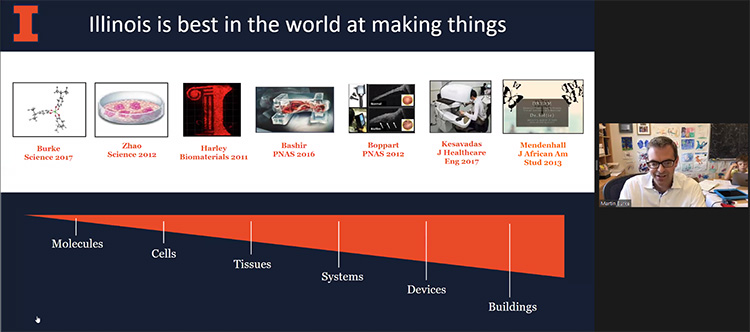
During Marty Burke's (right) introductory remarks, he cites some of the many innovations across scale at Illinois.
Here’s what the Make-a-Thon competition itself was like. It began with a video, “What is the Health Maker Lab?” which described the Maker Lab system and its goals. Then introducing the competition were two of the MCs, Marty Burke, Illinois Chemistry Professor and CI MED Associate Dean for Research, along with Ruby Mendenhall, Sociology Professor and Assistant Dean for Diversity and Democratization of Health Innovation at CI MED. They shared several relevant pieces of information, including the role of the citizen scientist in the democratization of health innovation, and how Dolphin Tank and audience members were to vote via the app. Following these introductory remarks, fellow MC Irfan Ahmad then introduced the Health Maker Lab Nodes, the judges, and thanked the many mentors assigned to help the 20 finalists. Helping Ahmad with the logistics of clock management and keeping the event running in a timely fashion was fellow MC Lisa Goodpaster, Associate Director for Project Management at CI MED and a member of the HML Executive Team. She was assisted by CI MED colleagues Angie Ellis, Office Administrator, Todd Patrick, Systems Engineer, and HML Intern Malaak Saadah, a junior in Materials Science and Engineering.
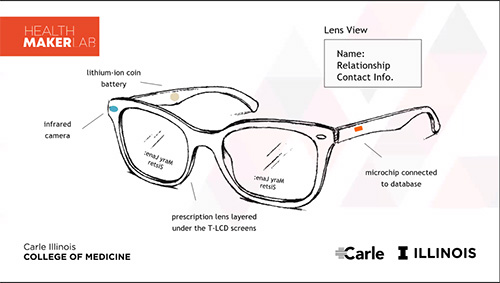
One of the 20 finalists: the Alzheimer’s Facial Recognition System.
Next came the main event of the program—the 20 finalists gave their 2-minute pitches. Ahmad and Goodpaster kept the competition running like clockwork. After making a quick test to ensure that the presenter(s) could be seen and heard via Zoom, each individual or team had two minutes to pitch their ideas, two minutes for Dolphin Tank judges to ask questions, and one minute for judge and audience voting—all strictly enforced by Ahmad and Goodpaster.
Ideas pitched by the 20 finalists included a diverse selection of health-related ideas. For example, the Alzheimer’s Facial Recognition System, the brainchild of University Laboratory High School students Mariam Vaid, Amalia Bollero, Firmiana Yi-Tong, and Anya Troyer, consisted of a special pair of glasses linked to a database and equipped with tools that utilize facial recognition software to identify individuals, plus other tools, such as reminders to take medicine and GPS tracking.
One of the youngest participants was a K-12 student, Owen Berbaum, whose idea was a Healthy Lunch Tray for Kids. He pitched a foldable, reusable lunch tray/box that follows USDA's MyPlate Guidelines and teaches kids healthy nutrition.
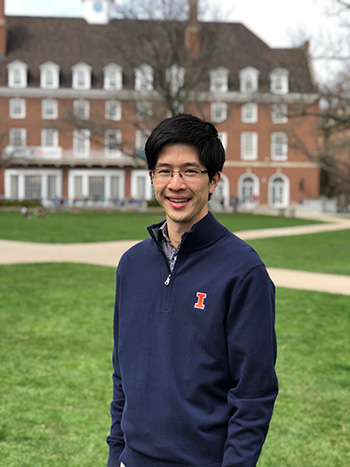
Kenneth Leung. (Image courtesy of Kenneth Leung.)
Kenneth Leung’s idea was “Get Rid of the Goop!” According to Leung, developing countries lack gel. So his notion was to create a low-cost gel adhesive for point-of-care ultrasound devices in order to increase access to ultrasound imaging in settings where such services are unavailable due to inconvenience in transporting heavy and bulky ultrasound gel.
Leung explains why he got involved with the competition. “I have been very interested in point-of-care ultrasound imaging, seeing it can help expedite diagnosing medical conditions and providing timely care,” he explains. “I try to identify barriers that prevent adoption and wider use of beneficial medical technologies and then find a way to break down those barriers.”
Regarding the benefit of being involved with the competition, Leung reports that he enjoyed the experience of pitching an idea in front of a wide panel of judges and audience.
“As a finalist,” he says, “we were connected with clinical and engineering experts at Carle and at University of Illinois Urbana-Champaign in the fields of ultrasound imaging and biomaterials. I had the opportunity to dig further into my idea and to learn from these enthusiastic experts who provided a lot of invaluable resources.”
Adding that he considered the experience and the opportunity to interact with Carle and UIUC experts “amazing!”, he looks forward to submitting additional ideas in future Health Make-a-Thons.
Once all 20 finalists had presented their pitches, the votes by judges (and audience members) were tabulated. While winners were being decided, Ruby Mendenhall and Irfan Ahmad shared some information about CI-MED and HML For instance, Mendenhall announced the creation of a new maker lab node called “Designing Resiliency and Well-being (DRAW).
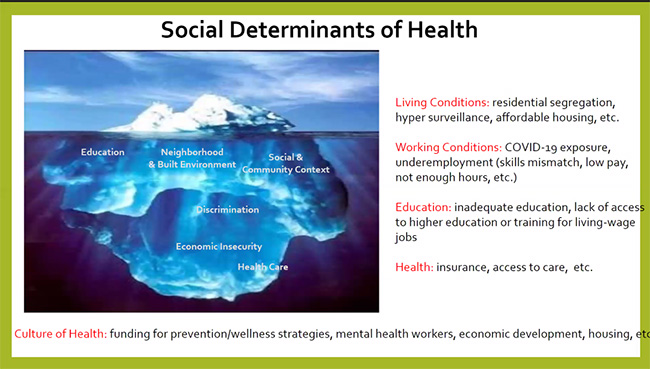
Above: A slide from Ruby Mendenhall's presentation about the new node focusing on health innovations that address social determinants of health.
Below: Ruby Mendenhall, CI MED Assistant Dean presents the new HML node about social determinants.
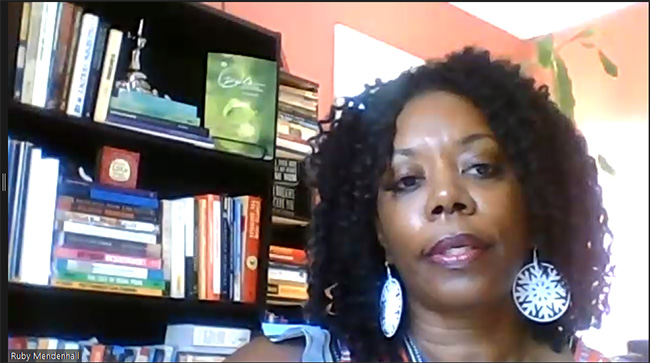
According to Mendenhall, "The new node will focus on creating health innovations that address social determinants of health (e.g., poverty, racism, housing, etc.); health disparities; and health equity."
Next, Ahmad shared with the Zoom audience about Illinois Personal Protection Equipment (I-PPE) developed by the Carle-Illinois College of Medicine Health Maker Lab, in conjunction with the Grainger College of Engineering and the Krannert Center Costume Design.
The ten winning ideas—each to receive $10,000-worth of HML services—addressed a variety of areas, ranging from apps to art to devices to redesigned wheelchair wheels. Following are the ten winners, their creators, and a short description of each.
- Anemone: A Safe Space in Your Phone by Ananya Cleetus (see below).
- Development of a Low-Cost, Portable, Non-Invasive, Positive Pressure Ventilation Device by Mobola Kukoyi.
- MePanel: An At-Home Compact and Multifunctional Metabolic Panel Test by Joy Chen and Adam Dama (see below).
- Paperometer by Shonit Nair Sharma (see below).
- PillSafe Smart Cap by Ariana Alam Mizan (see below).
- Projectscape by Sebastian Souryris, Aaron Brown, and Nekita Thomas.
- Sepsig—Our Fight for Early Detection of Sepsis by Kavya Sudhir, Sanjana Chunduri, Saloni Garg, and Trisha Yadav.
- Shift: Wheelchair Redesign by Wen Kun Yuan, Anna Chi, and Jessica Hung.
- Single Action Needles by Dylan Peters and David Kostryra.
- Ultrasonic Visual Aid by Emily Jean Smith, Natalie Ramsy, and Catherine Stauffer
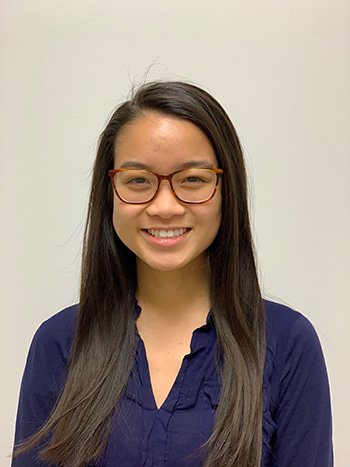
Bioengineering senior Joy Chen. (Image courtesy of Joy Chen.)
Making a surprise appearance toward the end of the program was the UI Chancellor Robert Jones, who made some closing comments. Jones appreciated the quality of the innovation ideas presented through the Health Maker Lab forum spanning the campus and off-campus community. Also, at the peak of the program 285 people attended the event, including those from 10 countries.
Below, several winners share how and why they came up with their ideas and what seeing their ideas come to life over the next year means to them. For example, Bioengineering senior Joy Chen, who, along with software automation engineer Adam Dama (a 2019 Bioengineering graduate from Illinois) came up with the MePanel, shares that when looking at patient-oriented healthcare technologies their own families have dealt with, the idea of blood tests emerged.
“Blood work is integral to almost every treatment plan and is oftentimes the very first step to a diagnosis and continues to be an important component through treatment,” Chen acknowledges. “But, getting blood work done isn’t always conveniently available to those who need it the most, and it can be risky for certain patients to go into a clinic to get blood work done.”
So the two of them conceptualized an at-home blood testing device that can offer a safer, quicker, and more convenient way for a patient to test the levels of the various components of their blood, much as a traditional metabolic panel would. “This is geared towards patients needing frequent blood work,” she explains, “like those undergoing chemotherapy or treating a chronic condition, and can especially benefit those patients who are immunocompromised, since they can do it from the comfort of their home.”
According to Chen, their device’s name, MePanel, is short for the metabolic panel it performs and implies a personalized experience, the two main focuses they envisioned for their device. Chen indicates that through this process, she’s learned a lot about research, engineering design, and multidisciplinary collaboration to help hone their idea. “It was fascinating to envision how we could piece together the device and perform the steps we wanted it to,” she says.
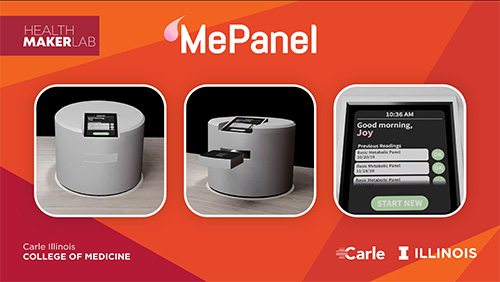
MePanel slide from Joy Chen and Adam Dama's 2-minute pitch. (Image courtesy of Joy Chen.)
Chen says a key part of this process was connecting with patients, engineers, and physicians to “further develop the technicalities of the device and put it in the context of hospital needs.” Physicians emphasized the need for such a device from both the physician’s and patient’s perspective and helped them focus the device’s capabilities and patients it would be suited for. Bioengineering Professor Joseph Irudayaraj, whose lab develops biosensors, gave input regarding the feasibility, technical aspects, and estimated costs of their proposed device.
Regarding developing a prototype Chen admits, “I have personally learned so much through this experience, and it’s been an incredible journey thus far. Over the course of the next year, we hope to finalize our design and start prototyping our product. We are looking forward to working with our mentors and the amazing maker community to bring our project to the next level.”
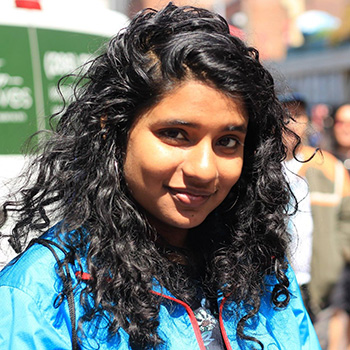
Ananya Cleetus from team Anemone. (Image courtesy of KAnanya Cleetus.)
Ananya Cleetus from team Anemone, one of the winners, shares about why she chose her project.
“I think mental health is still one of the most stigmatized topics in the world today. I've struggled a lot with my own mental health in college, specifically bipolar disorder, and realize how important it is to talk about mental health crises, but it's still a difficult topic to broach for people my age.”
Cleetus shares some of the benefits of participating in the competition. “I gained a lot through the Make-a-thon experience, especially in working with my mentors and getting good feedback and questions from the judges. It was especially nice to have multiple mentors with different sets of experience and insight who could weigh in on both the tech side of my project as well as the social impact potential.” She says she also enjoyed watching the other finalists present their pitches during the competition.
Cleetus acknowledges that she’s grateful for the opportunity to continue working on Anemone and to further develop the app with support from Carle, Illinois, and her mentors.
“Mental health is growing in importance,” she admits, “especially during the pandemic and quarantine, and I'm excited to improve Anemone and share it with an even larger audience.”
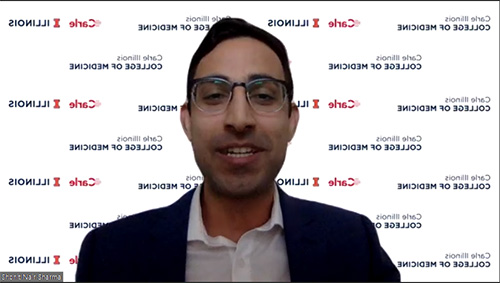
Above: Shonit Nair Sharma, a medical student at Carle Illinois College of Medicine, describes his winning idea the “Paperometer’
Below: Sharma's Paperometer model.
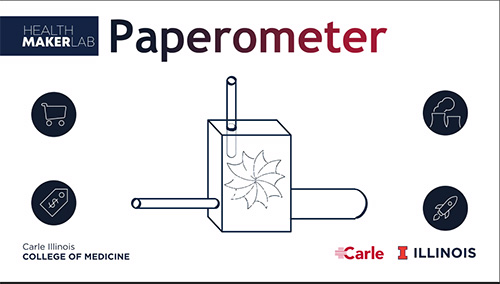
Another winner, Shonit Nair Sharma, a medical student at CI MED, describes his winning idea, the “Paperometer’—an incentive spirometer made entirely out of paper which can be used for respiratory rehabilitation in patients with coronavirus-related pulmonary symptoms. His idea would reduce the cost and environmental burden related to providing access to medical devices such as respirators.
He shares how he came up with his idea. One day in medical school, some respiratory therapists showed him and his fellow medical students medical devices they use on a daily basis. “After playing around with some of these respiratory rehabilitation devices, I noted some recurring design flaws,” he acknowledges. “Some seemed overly complicated to use while others were very bulky. Most of the devices were also single-use and made out of plastic. I saw an opportunity to innovate.”
Knowing that the Health Make-a-Thon was coming up, Sharma submitted his idea for a paper incentive spirometer “—an idea I believed had the potential to improve access to a much-needed device,” he recalls. While ecstatic to discover that he’d been selected as a finalist, he was originally disappointed due to the postponement of the competition due to COVID-19. However, as the coronavirus spread, he saw the need for his device grow. Not only is the incentive spirometer used for individuals recovering from pneumonia, but he learned from current research that it was helping with coronavirus too. When the Virtual Health Make-a-Thon was announced, he reports, “I was reinvigorated to share with the community my idea to improve human health on a global scale—but this time, particularly motivated to help the world overcome our current situation.”
As for his involvement with the Make-a-Thon, he adds, “I personally very much enjoy the process of innovating—from identifying a need, to coming up with ideas to meet that need, to implementing a solution.”
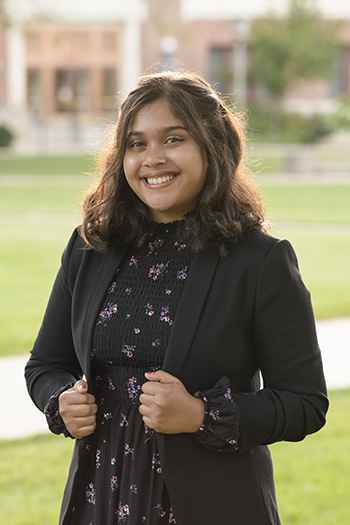
Ariana Mizan, creator of the PillSafe Cap. (Image courtesy of Ariana Mizan.)
In fact, he enjoys the process so much that he intends to sponsor a capstone design team at Illinois, guiding senior Bioengineering undergrads through the innovation process themselves. “Just as I had the revelation that I could apply my engineering expertise to address clinical problems in healthcare as a future physician-innovator,” he explains, “I am looking forward to mentoring the next generation as they might discover the same.”
Another winning idea was the PillSafe Cap and App. Fifteen-year-old Ariana Mizan, a rising junior at University Laboratory High School on campus, shares an anecdote about how her idea was conceived.
“The Opioid crisis became real to me, she shares, “when I learned that a family friend had been prescribed sleeping pills, and accidentally took more than prescribed which resulted in addiction for years. I learned that this opioid crisis is actually a public health pandemic. I became inspired to jot down ideas to solve a real-world problem like the misuse of opioids.” She adds that this led to her idea: the PillSafe Cap and App—which she claims is a possible solution to the ease of access for highly addictive medication.
Regarding the Health Make-a-Thon competition, Mizan declares, “To be surrounded by a diverse group of brilliant minds is awe-inspiring, and the opportunity to present my ideas to world-class academics, leaders, and innovators was an honor. I came away from the experience realizing that each of us has the capacity and ability to create a better world with innovation and creativity.”
Mizan shares what winning means to her, adding, “I am excited to see that a drawing on a piece of paper a year ago might become a reality with the help and support of the University of Illinois Healthmakers team. To continue to work on this with the University of Illinois Engineering and the College of Medicine is a way for me to make a difference and learn how inventors become inventors.”
*Note: To get involved with the Health Maker Lab, contact: Irfan Ahmad, isahmad@illinois.edu.
Story by Elizabeth Innes, Communications Specialist, I-STEM Education Initiative. Photos by Elizabeth Innes unless otherwise noted..
For more related stories, see: Carle Illinois, 2020
For an additional I-STEM articles about Carle Illinois College of Medicine, see:
- Health Make-a-Thon Encourages Local Citizens to Dream Up Ideas for Improving Health
- The (Future) Doctor is in the House: Meet an Illinoisan in the Inaugural Carle Illinois Medical Program
- Underrepresented Minority Undergraduate Students Gain Research, Clinical Experience Via the Carle Illinois College of Medicine’s New REACH RCEU
- Undergrad Brione Griffin Gets One Step Closer to Her Dream of Becoming a Doctor Via REACH RCEU

Wen Kun Yuan (right) compares a normal wheelchair to their Shift design during the winning Shift Wheelchair Redesign team's 2-minute pitch.

Mobola Kukoyi (right) shares her 2-minute pitch about her winning idea: "Development of a Low-Cost, Portable, Non-Invasive, Positive Pressure Ventilation Device."
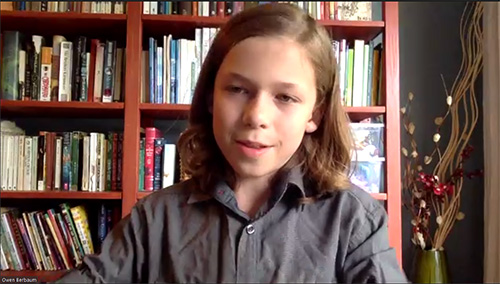
Owen Berbaum discusses his idea, a Healthy Lunch Tray for Kids during the question and answer period following his pitch.
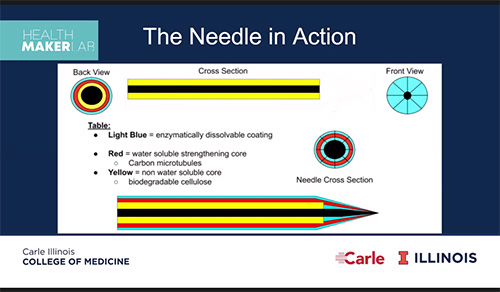
Single Action Needles, winning idea by Dylan Peters and David Kostryra.













.jpg)
















